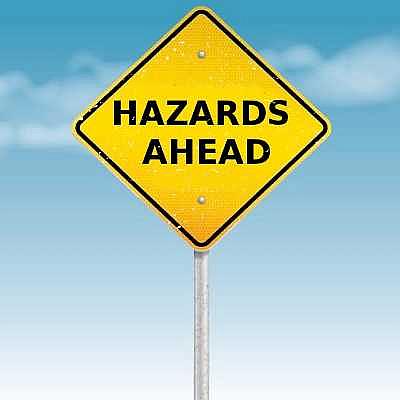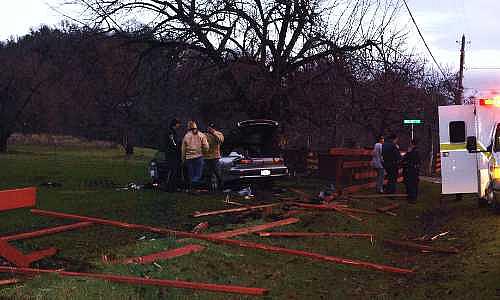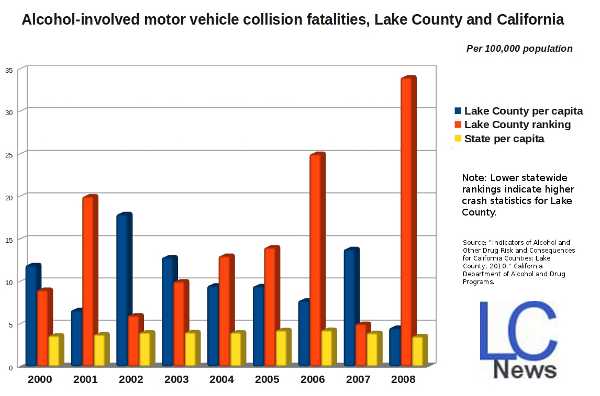Alcohol adds a deadly element to area roadways
This is the second installment of a special series on highway safety and its impact on Lake County residents' health.
Part 1: Vehicle crash rates among Lake County's chief health issues
Part 2: Alcohol adds a deadly element to area roadways
Part 3: Many agencies contribute to roadway safety projects, planning


A man from Lakeport, Calif., died on Sunday, January 2, 2011, after his vehicle slammed into a fence near Upper Lake, Calif. A fence cross member hit the man in the face and killed him, but his passenger was unhurt. The California Highway Patrol concluded the driver was under the influence.
LAKE COUNTY, Calif. – Last year, county health officials and partner agencies, groups and hospitals completed the 2010 Lake County Health Needs Assessment.
That document looked at a number of significant health topics in an effort to help policymakers address areas of concern.
Among its findings: Based on county and state public health statistics, between 2006 to 2008 Lake County’s motor vehicle crash death rate was more than twice the state level, nearly twice the national level and close to three times the national health objective.
The Lake County Health Needs Assessment also found Lake County’s average rate of alcohol-involved motor vehicle fatalities for 2001 to 2003 was three times higher than the state average.
Those rates concerned public health officials like Dr. Karen Tait, the county's health officer, who pointed out that Lake County's roadways already are challenging due to the area's unique geography.
Those roads, combined with drivers under the influence, has led to an increasingly deadly situation on county roadways.
Local crash rates higher than state, national averages
A California Department of Alcohol and Drug Programs report, “Indicators of Alcohol and Other Drug Risk and Consequences for CA Counties – 2010,” found that Lake County's rate of alcohol-involved vehicle collisions was “significantly higher” than the state's annual average.
Between 2000 and 2008, Lake County's number of alcohol-involved motor vehicle fatalities showed significant variations, but in 2007 it was ranked fifth-highest in the state, with a per capita ranking of 13.80, compared to a statewide per capita crash rating of 3.94.
While the report considers alcohol-involved motor vehicle collisions, it doesn't look at the rate of drug-involved collisions.
A Lake County News analysis of DUI- and drug-related crashes from 2006 to 2010 shows that drug use amongst people involved in fatal collisions was equal to – and, in some cases, slightly greater than – alcohol use.
The California Department of Alcohol and Drug Programs report showed that deaths due to drug and alcohol abuse have gained Lake County an average statewide ranking as second-highest in California.
In 2006 Lake was the county with the highest rate of death related to alcohol and drug use in California, the report showed.
The University of Wisconsin Population Health Institute's county health rankings, completed earlier this year, found that Lake County's motor vehicle crash fatality rate was ranked among the worst in the state between 2001 and 2007.
The study suggested that a major contributing factor to that high crash rate was alcohol use, with “excessive drinking” another serious health factor in the county – a conclusion similar to those reached in the county needs health assessment.
The University of Wisconsin study defined excessive drinking as consuming more than four drinks for women or five drinks for men on a single occasion in the previous 30 days, or heavy drinking, defined as drinking more than one drink for women or two drinks for men per day on average.
The California Department of Public Health's County Health Status Profiles for 2011, which looked at the years 2007 through 2009, showed that Lake County had an age-adjusted death rate from motor vehicle crashes of 20.9 per 100,000 population.
That rate is more than twice the statewide average of 9.2, and well above the Healthy People 2010 national health objective of 8. The 2011 figures gained Lake County a statewide rank of 54th worst out of 58 counties.
Looking at a wider set of data, a review of California County Health Status Profiles from 1999 to 2011 showed a dynamic change in the vehicle crash and death rate during that time period, with the number of deaths and the county's ranking climbing dramatically beginning in the 2000-01 timeframe.
The news on county crashes isn't all negative. One study, the Lake County Maternal, Child and Adolescent Needs Assessment: 2010-2014, showed that progress had been made in reducing motor vehicle injuries for children and youth.

Mirroring national trends
Not all research shows Lake County's numbers topping national trends. In fact, based on a recent federal report, when it comes to the number of fatal crashes involving driving under the influence, Lake County's numbers appeared just slightly below the national average in 2010.
An October report from the Centers for Disease Control and Prevention, “Vital Signs: Alcohol-Impaired Driving Among Adults – United States, 2010” reports that nearly 11,000 crash fatalities, or about one third of all crash fatalities in the United States in 2010, were attributed to DUI.
According to the data Lake County News gathered from local law enforcement, 16 fatalities occurred on local roadways in 2010; of those, four – or 25 percent – were concluded to be DUI-related.
Looking at a larger statistical sample provided by the National Highway Traffic Safety Administration show, the information showed that Lake County had 78 highway fatalities – 10 involving motorcycles – from 2005 through 2009.
Twenty-one of those fatalities – or nearly 27 percent – involved alcohol-impaired driving, 19 involved speeding, 10 occurred at intersections, 21 involved rollovers and 59 were related to going off the roadway.
What can communities do? The CDC report suggests sobriety checkpoints and additional enforcement to counter the high rates of alcohol-impaired crashes.
Here in Lake County, the California Highway Patrol's Clear Lake Office did just that, using a “Five Alive” grant that ran from Oct. 1, 2010, through this past Sept. 30, and was provided by a grant from the California Office of Traffic Safety through the National Highway Traffic Safety Administration.
The grant's purpose, according to the CHP, was “to reduce the number of people killed and injured in alcohol- and motorcycle-involved collisions on local highways.”
The program used a combination of public education, 252 individual DUI saturation patrols, four motorcycle safety operations conducted during motorcycle rallies and eight DUI motorcycle enforcement task force operations. CHP said it partnered with other local law enforcement agencies to carry out the operations.
Based on the CHP's statistical tracking of the grant's program, Lt. Greg Baarts, commander of the Clear Lake Area office, said the preliminary figures show a decrease both in DUI-related fatalities and motorcycle-involved collisions.
